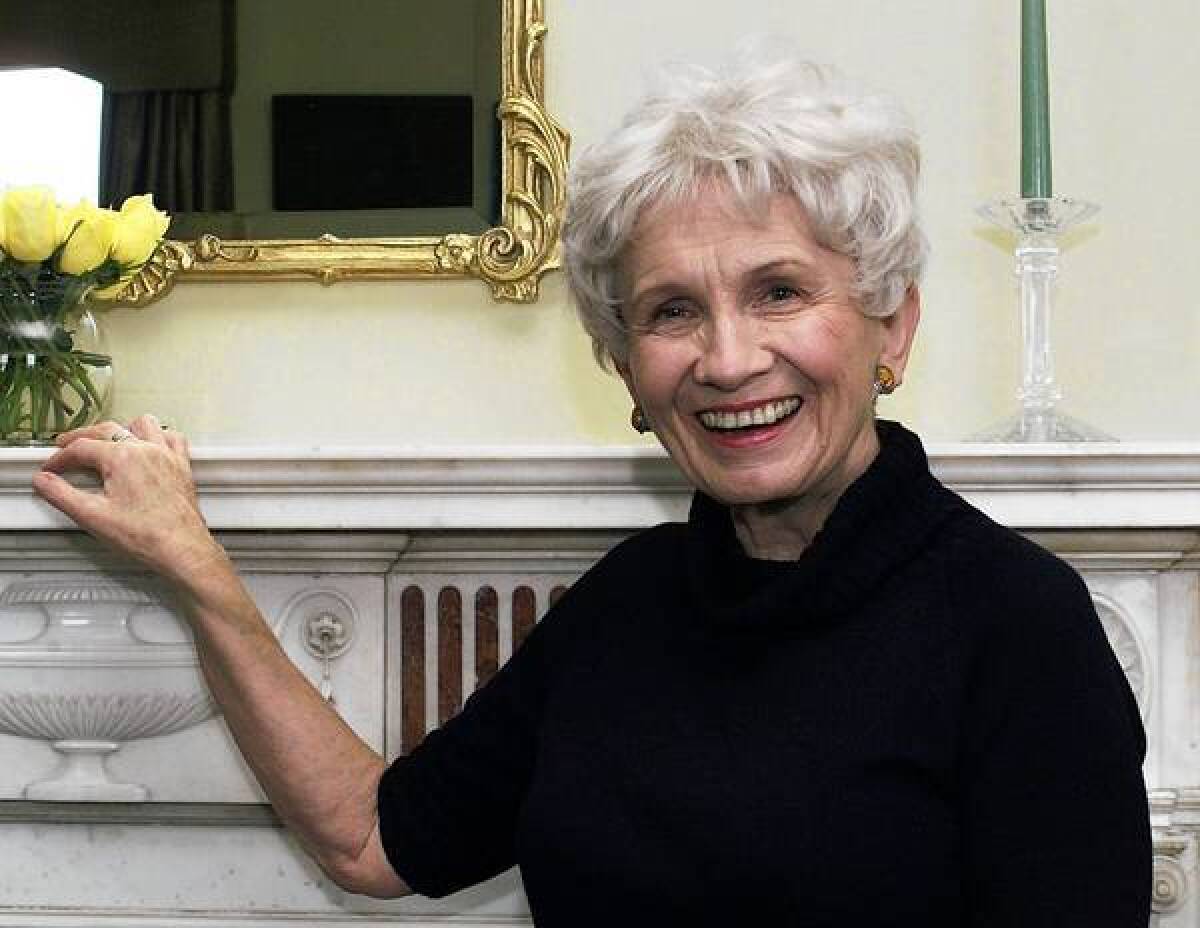Alice Munro, Nobel winner and a writer’s peerless teacher

- Share via
Alice Munro was my teacher.
No, I’ve never actually met the Canadian writer, who was enshrined Thursday as a Nobel laureate for literature. I mean she was my “teacher” in that way we writers think about the great authors whose published works instruct us in what the art can be.
Like many other writers, I turned to Munro for help with a certain essential element of the craft of literary fiction. She taught me to see the glories of the everyday, the epic inside the ordinary.
An Alice Munro story is the antithesis of melodrama. She doesn’t resort to theatrics or overwrought tragedies to move her story forward, or shed copious amounts of blood — though when she does, the violence is really an act of misdirection, intended to distract you while she reveals something that’s been sitting there in the lives of her characters all along.
Plot almost always feels like a matter of secondary importance in Munro’s fiction.
Instead, her stories unfold as precise character studies: about daughters and their fathers, about spinster aunts who wear “merino wool” dresses, and about distracted mothers who worry about their slips showing and who take to their chores with brushes and “scrub pails.” Above all, Munro writes about men and women who live long enough, or intensely enough, to learn profound truths about the people closest to them. Her stories are about the great interior journeys people can take — without traveling very far beyond the Ontario towns where most of her stories are set.
Munro taught me to slow down as a writer. Stay here, in this moment, in this living room or on this patch of land a bit longer, she told me, and you’ll be surprised at the things you might find.
Consider the story “Fits,” from her 1986 collection “The Progress of Love,” in which a murder-suicide takes place offstage. We learn little about the victims, because the story is really about the ordinary family that lives next door, a married couple and their teenage children. Munro moves backward and forward in the family’s history and the only “murderous” thing that happens to the protagonists is when the husband remembers a long-ago argument with a former lover:
“They trembled with murderous pleasure, with the excitement of saying what could never be retracted; they exulted in wounds inflicted but also in wounds received, and one or the other said at some point, ‘This is the first time we’ve spoken the truth since we’ve known each other!’”
To read Munro, and especially classic anthologies such as “The Beggar Maid” and “The Moons of Jupiter,” is to enter a world of emotional entanglements in which many generations of a family’s history might be squeezed into a few dozen pages of her fierce and passionate prose.
After reading a dozen or so Munro stories, I learned how much “authority” a writer can and should have, how much she has every right to observe and opine on the values and the mores of her time and place. In “Fits,” Munro dissects the shared prejudices and idiosyncrasies that unite the town of Gilmore, a place “where everything becomes known, sooner of later” and where “much of conversation is repetition, a sort of dance of good intentions, without surprises.”
I learned later that the towns in most of Munro’s stories are stand-ins for real-life Huron County, in southwestern Ontario. Munro grew up there, moved away, then moved back after she’d become a parent and grandparent. It’s a region said to resemble the American Midwest. As “Wild” writer Cheryl Strayed wrote in a 2010 essay for the Missouri Review: “Munro evokes this hardscrabble place with searing specificity: its ramshackle farms and rutted roads, its small towns and social institutions and the complicated and contradictory, proud and humiliated, vain and self-effacing people who populate it.”
It was a U.S. writer, Cynthia Ozick, who called Munro “our Chekhov.” She used the first-person plural, I suppose, to refer to us North Americans of the late 20th and early 21st centuries, a people living in relative comfort, but struggling to achieve that one thing that makes us feel fully human: intimacy.
Like Chekhov, Munro wanted to write a novel, but the closest she came was “Lives of Girls and Women,” a collection of intertwined stories often labeled a “short story cycle.” She published her first collection of stories at age 36, which would make her a late bloomer in today’s literary circles. Describing her struggles to keep on writing as she approached and passed 40, she told the Paris Review in 1994: “It was a kind of desperate, desperate race.”
Munro won the race, and kept on writing. That’s the most recent lesson Alice Munro taught me: keep going. Last year at age 81 she published the story collection “Dear Life.” After a half-century of writing, it was likely the work that sealed the deal for the Nobel committee.
Hector Tobar, a Times book critic, is the author of several books, including the novel “The Barbarian Nurseries.”
More to Read
Sign up for our Book Club newsletter
Get the latest news, events and more from the Los Angeles Times Book Club, and help us get L.A. reading and talking.
You may occasionally receive promotional content from the Los Angeles Times.










